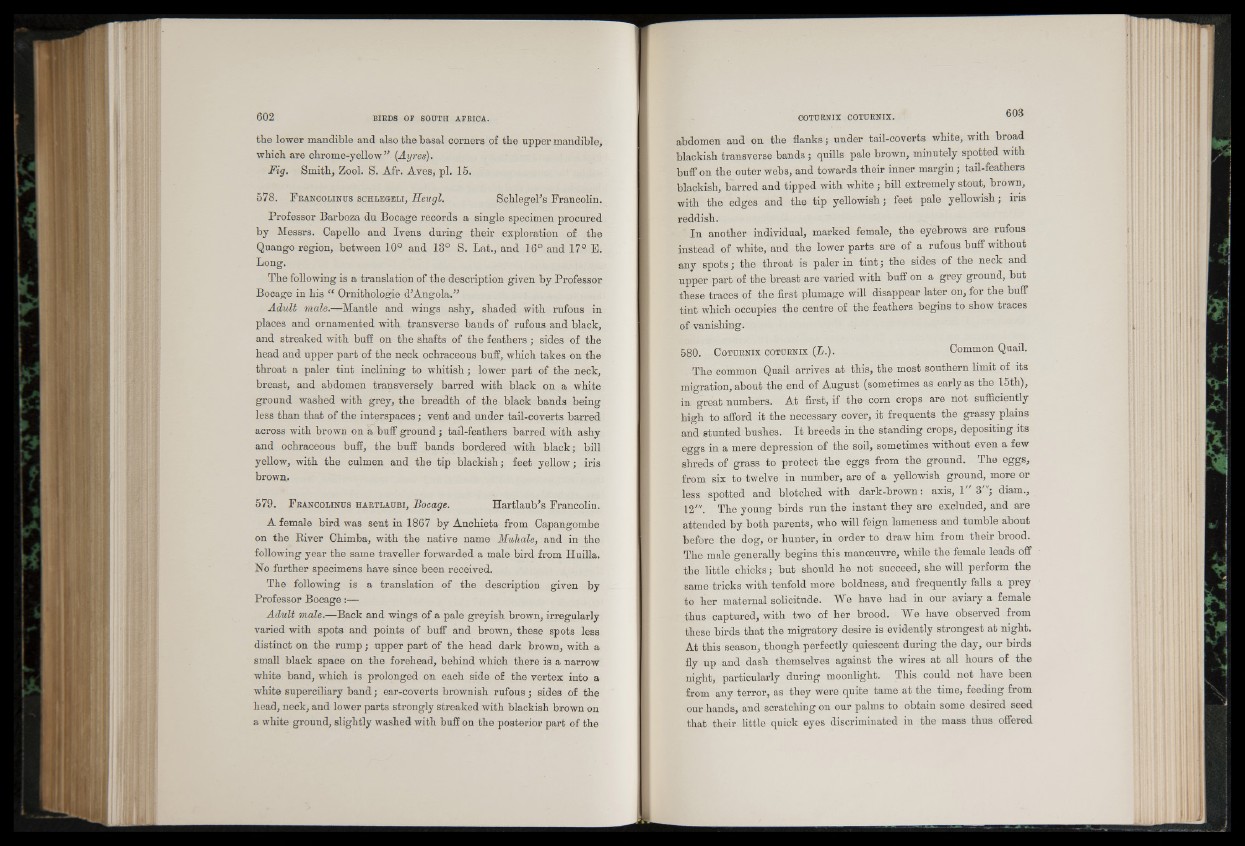
the lower mandible and also the basal corners of the upper mandible,
which are chrome-yellow5’ (Ayres).
Fig. Smith, Zool. S. Afr. Aves, pi. 15.
578. F r a n c o l in u s s c h l e g e l i , Heugl. Schlegel’s Francolin.
Professor Barboza du Bocage records a single specimen procured
by Messrs. Capello and Ivens during their exploration of the
Quango region, between 10° and 13° S. Lat., and 16° and 17° E.
Long.
The following is a translation of the description given by Professor
Bocage in his “ Ornithologie d’Angola.”
Adult male.—Mantle and wings ashy, shaded with rnfous in
places and ornamented with transverse bands of rufous and black,
and streaked with buff on the shafts of the feathers; sides of the
head and upper part of the neck ochraceous buff, which takes on the
throat a paler tint inclining to whitish; lower part of the neck,
breast, and abdomen transversely barred with black on a white
ground washed with grey, the breadth of the black bands being
less than that of the interspaces; vent and under tail-coverts barred
across with brown on a buff ground; tail-feathers barred with ashy
and ochraceous buff, the buff bands bordered with black; bill
yellow, with the culmen and the tip blackish; feet yellow; iris
brown,
579. F e a n c o l in u s h a e t l a u b i , Bocage. Hartlaub’s Francolin.
A female bird was sent in 1867 by Anchieta from Oapangombe
on the River Chimba, with the native name Muhale, and in the
following year the same traveller forwarded a male bird from Huilla.
No further specimens have since been received.
The following is a translation of the description given by
Professor Bocage:—
Adult male.—Back and wings of a pale greyish brown, irregularly
varied with spots and points of buff and brown, these spots less
distinct on the rump; upper part of the head dark brown, with a
small black space on the forehead, behind which there is a narrow
white band, which is prolonged on each side of the vertex into a
white superciliary band; ear-coverts brownish rufous ; sides of the
head, neck, and lower parts strongly streaked with blackish brown on
a white ground, slightly washed with buff on the posterior part of the
abdomen and on the flanks; under tail-coverts white, with broad
blackish transverse bands; quills pale brown, minutely spotted with
buff on the outer webs, and towards their inner margin; tail-feathers
blackish, barred and tipped with white; bill extremely stout, brown,
with the edges and the tip yellowish; feet pale yellowish; iris
reddish.
In another individual, marked female, the eyebrows are rufous
instead of white, and the lower parts are of a rufous buff without
any spots; the throat is paler in tin t; the sides of the neck and
upper part of the breast are varied with buff on a grey ground, but
these traces of the first plumage will disappear later on, for the buff
tint which occupies the centre of the feathers begins to show traces
of vanishing.
580. C o t u e n ix COTUENIX (L.). Common Quail.
The common Quail arrives at this, the most southern limit of its
migration, about the end of August (sometimes as early as the 15th),
in great numbers. At first, if the corn crops are not sufficiently
high to afford it the necessary cover, it frequents the grassy plains
and stunted bushes. It breeds in the standing crops, depositing its
eggs in a mere depression of the soil, sometimes without even a few
shreds of grass to protect the eggs from the ground. The eggs,
from six to twelve in number, are of a yellowish ground, more or
less spotted and blotched with dark-brown | axis, 1" 3 "'; diam.,
12'". The young birds run the instant they are excluded, and are
attended by both parents, who will feign lameness and tumble about
before the dog, or hunter, in order to draw him from their brood.
The male generally begins this manoeuvre, while the female leads off
the little chicks; but should he not succeed, she will perform the
same tricks with tenfold more boldness, and frequently falls a prey
to her maternal solicitude. We have had in our aviary a female
thus captured, with two of her brood. We have observed from
these birds that the migratory desire is evidently strongest at night.
At this season, though perfectly quiescent during the day, our birds
fly up and dash themselves against the wires at all hours of the
night, particularly during moonlight. This could not have been
from any terror, as they were quite tame at the time, feeding from
our hands, and scratching on our palms to obtain some desired seed
that their little quick eyes discriminated in the mass thus offered